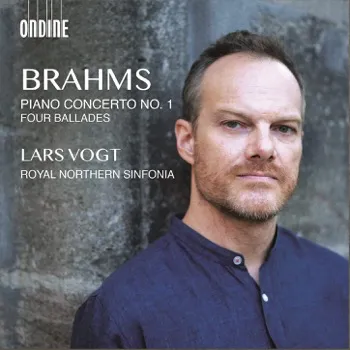This is special in many ways, not only for the musicianship but also for the performance practice. As in his Beethoven cycle with the Royal Northern Sinfonia, Vogt performs the mighty D minor Concerto by Brahms from the keyboard, and following the monumental piece with the 4 intimate ballads for solo piano (Op. 10). Vogt has recorded Brahms chamber works before, most notably the Violin Sonatas and Piano Trios, but this is his first Concerto recording of the composer, and his first solo-Brahms performance in many years.

The performance of the concerto captures its austere drama and highlights the textural complexity of Brahms’ writing. Despite a slightly early timpani entrance in the first movement, the orchestral opening commands the listener’s attention. The quieter part of the introduction could use more phrase shaping and dynamic changes, as it tends to murmur in some places. This is far removed from the celebrated Curzon/Szell’s Decca recording (1962), where the opening is sharper and more contrastive in character, so one can sense a dramatic urgency that juxtaposes well with the brooding, softer section. But then again – how many can compete with this legendary Decca recording, or with Szell for that matter?
Vogt’s entrance is pensive, but it could do with more presence, especially in light of the thick preceding orchestral texture. However, there is good large-scale momentum and dialogue between soloist and orchestra, critical in a movement of this length and intensity. The second movement embodies the very spirit of the composer’s expressivity, and is indeed the best in this Concerto performance. Despite being a classicist, Brahms wrote with a rich polyphony and vivid harmonic language. Both Vogt and the orchestra emphasize these elements, leaving the listener emotionally captivated. The thinner textures also give Vogt an ample opportunity to display his masterful voicing technique, shown in many past recordings, as in his latest Mozart Sonatas recording, reviewed in these pages.
The third movement opens with good energy, though the orchestra does sound light-handed here. In sharp contrast, in Helene Grimaud’s second recording (DG, 2013), the VPO carries more weight than a listener might be looking for. Vogt’s approach of crisp staccatos, unparalleled articulation and steady rhythm, however, give the opening its stern vitality. The rondo’s presentation of vignettes of different characters, ranging from romantic to heroic – is vividly expressed here. The orchestra bolsters his musicality; when it comes into full richness slightly before and during the expansive B-flat major interlude, it’s an impressive moment indeed (track 3, 4’03”). The final D major section complements an already solid performance: there is good clarity of orchestral melodic lines and a powerful buildup from both piano and orchestra to a triumphant finale. The entire performance is remarkable, especially given that the ensemble is a chamber orchestra – smaller than the standard for this sort of work, but perhaps not that far off from the sizes of ensemble Brahms first performed the work with. It’s also not so common to find the orchestra conducted form the piano in this Concerto, as Vogt does here.
Contemplative Side
If the concerto shows the dramatic side of Brahms, the Op. 10 Ballades display his contemplative side. Written when he was 21, the pieces are markedly different from his later works, already manifest a compositional complexity and exploratory harmonies all while possessing a youthful imaginativeness, hinting to his mature style. Vogt captures these elements while adding a layer of deep introspection. In No. 1, he emphasizes melodic lines in terms of their different textures. In the recapitulation, for instance, the marked staccatos are a multidimensional, addition to the melody. At the same time, the hymn-like section is presented with a lovely, calibrated balance.
No. 2 puts Vogt’s musical sensitivity on full display. Every group of notes is meticulously attended to: one unifying factor of this piece is the motif of 4 short notes which takes many forms, from a single line to part of a chordal structure. Each time, he carefully considers the character changes of this motif, unifying the entire ballade for the listener. No. 3 is perhaps Vogt’s finest performance. His articulation is highly nuanced, helped in large part by the fact that he never overpedals. From a performer’s standpoint, it is easy to forget about the sustained bass notes in favor of the more active melodic line, but Vogt places equal importance on both. This creates a depth of sound that makes the melodic line even more salient and vibrant. The pianist also makes beautiful use of the piano’s timbres, treating the instrument as an orchestra: in the middle of the piece, when Brahms writes in a high register, Vogt plays these notes with a delicate bell-like sound. He then adds to this with the legato middle and eventually the rich, low bass notes.
Written in a lied form, No. 4 is also lovely. Both the voice and accompaniment lines have their singular character and presence, and the piece becomes a conversation. In the middle section (1’32”), the melody does get lost in the accompaniment at times, but Vogt does well with subtlety, making the subsequent recapitulation feel like being freshly awoken from a dream.
The liner notes are an extremely valuable read, presenting Vogt’s own deep insights into his experiences as both conductor and pianist of a technically formidable concerto. His commentary on the Op. 10 Ballades also gives a glimpse into his own imagination and musicality, adding to the listener’s understanding of his interpretation. I’d be interested to know what he might do with the Second Piano Concerto or the 116-119 piano pieces.
Brahms – Piano Concerto No. 1 in D Minor, Op. 15, 4 Balleds, Op. 10
Lars Vogt – Piano and Conductor
Royal Northern Sinfonia
Ondine, CD ODE 1330-2




















